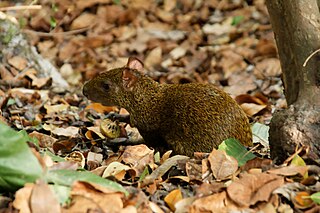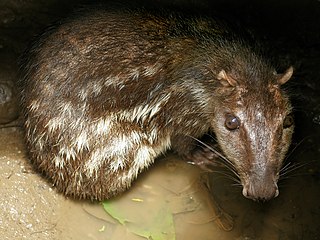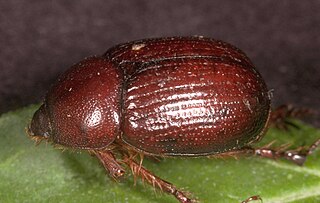
Gandia is a city and municipality in the Valencian Community, eastern Spain on the Mediterranean. Gandia is located on the Costa del Azahar, 65 kilometres (40 mi) south of Valencia and 110 km (68 mi) north of Alicante. Vehicles can access the city through road N-332.

The lowland paca, also known as the spotted paca, is a large rodent found in tropical and sub-tropical America, from east-central Mexico to northern Argentina, and has been introduced to Cuba and Algeria.

The term agouti or common agouti designates several rodent species of the genus Dasyprocta. They are native to Middle America, northern and central South America, and the southern Lesser Antilles. Some species have also been introduced elsewhere in the West Indies. They are related to guinea pigs and look quite similar, but they are larger and have longer legs. The species vary considerably in colour, being brown, reddish, dull orange, greyish, or blackish, but typically with lighter underparts. Their bodies are covered with coarse hair, which is raised when alarmed. They weigh 2.4–6 kg (5.3–13.2 lb) and are 40.5–76 cm (15.9–29.9 in) in length, with short, hairless tails.

A paca is a member of the genus Cuniculus of ground-dwelling, herbivorous rodents in South and Central America. It is the only genus in the family Cuniculidae. They are large rodents with dots and stripes on their sides, short ears, and barely visible tails. They are also referred to as "gibnuts" or "royal rats".

Eimeria is a genus of apicomplexan parasites that includes various species capable of causing the disease coccidiosis in animals such as cattle, poultry, dogs, cats, and smaller ruminants including sheep and goats. Eimeria species are considered to be monoxenous because the life cycle is completed within a single host, and stenoxenous because they tend to be host specific, although a number of exceptions have been identified. Species of this genus infect a wide variety of hosts. Thirty-one species are known to occur in bats (Chiroptera), two in turtles, and 130 named species infect fish. Two species infect seals. Five species infect llamas and alpacas: E. alpacae, E. ivitaensis, E. lamae, E. macusaniensis, and E. punonensis. A number of species infect rodents, including E. couesii, E. kinsellai, E. palustris, E. ojastii and E. oryzomysi. Others infect poultry, rabbits and cattle. For full species list, see below.

Tomarus is a genus of scarab beetles in the subfamily Dynastinae, the rhinoceros beetles. They are native to the Americas, where they are distributed from the central United States to Argentina, and a few species occur in the Caribbean.
The Oaxacan pocket gopher is a species of rodent in the family Geomyidae.

The European rabbit or coney is a species of rabbit native to southwestern Europe and to northwest Africa. It has been widely introduced elsewhere, often with devastating effects on local biodiversity. However, its decline in its native range, has caused the decline of its highly dependent predators, the Iberian lynx and the Spanish imperial eagle. It is known as an invasive species because it has been introduced to countries on all continents with the exception of Antarctica, and has caused many problems within the environment and ecosystems. Feral European rabbits in Australia have had a devastating impact, due in part to the lack of natural predators there.
Dinodnavirus is a genus of viruses that infect dinoflagellates. This genus belongs to the clade of nucleocytoplasmic large DNA viruses. The name is derived from 'dino' (dinoflagellate) and DNA.
Cuniculus hernandezi is a name coined for a proposed species of paca described as an endemic to the Central Andes in Colombia, the only place it has been identified as such to date. Individuals may weigh over 14 pounds (6.4 kg), making C. hernandezi a rather large rodent. The authors omitted a description of the animal, but it is thought to be very similar to the mountain paca, C. taczanowskii, from which this taxon was split. According to the authors, analysis of its mitochondrial DNA and karyotypy indicated that it may be a distinct species. The specific epithet honours Colombian biologist Dr. Jorge Hernández Camacho.
Tomarus neglectus is a species of rhinoceros beetle in the family Scarabaeidae.
Tomarus subtropicus is a species of rhinoceros beetle in the family Scarabaeidae.
Tomarus gibbosus, the carrot beetle, is a species of rhinoceros beetle in the family Scarabaeidae.

Cimolus is a genus of leaf-footed bugs in the family Coreidae. There are at least four described species in Cimolus.
Trischidias exigua, the trischidias exiguus, is a species of typical bark beetle in the family Curculionidae. It is found in North America.
Tomarus relictus is a species of rhinoceros beetle in the family Scarabaeidae. It is found in North America.

Hypselonotus punctiventris, the spot-sided coreid, is a species of leaf-footed bug in the family Coreidae. It is found in Central America and North America.
Tomarus sallaei is a species of rhinoceros beetle in the family Scarabaeidae.








